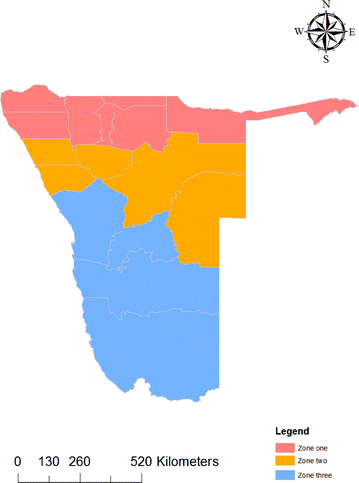Strengthening tactical planning and operational frameworks for vector control: the roadmap for malaria elimination in Namibia
- PMID: 26242587
- PMCID: PMC4524019
- DOI: 10.1186/s12936-015-0785-1
Strengthening tactical planning and operational frameworks for vector control: the roadmap for malaria elimination in Namibia
Abstract
Background: Namibia has made tremendous gains in malaria control and the epidemiological trend of the disease has changed significantly over the past years. In 2010, the country reoriented from the objective of reducing disease morbidity and mortality to the goal of achieving malaria elimination by 2020. This manuscript outlines the processes undertaken in strengthening tactical planning and operational frameworks for vector control to facilitate expeditious malaria elimination in Namibia.
Case description: The information sources for this study included all available data and accessible archived documentary records on malaria vector control in Namibia. A methodical assessment of published and unpublished documents was conducted via a literature search of online electronic databases, Google Scholar, PubMed and WHO, using a combination of search terms.
Discussion and evaluation: To attain the goal of elimination in Namibia, systems are being strengthened to identify and clear all infections, and significantly reduce human-mosquito contact. Particularly, consolidating vector control for reducing transmission at the identified malaria foci will be critical for accelerated malaria elimination. Thus, guarding against potential challenges and the need for evidence-based and sustainable vector control instigated the strengthening of strategic frameworks by: adopting the integrated vector management (IVM) strategy; initiating implementation of the global plan for insecticide resistance management (GPIRM); intensifying malaria vector surveillance; improving data collection and reporting systems on DDT; updating the indoor residual spraying (IRS) data collection and reporting tool; and, improving geographical reconnaissance using geographical information system-based satellite imagery.
Conclusions: Universal coverage with IRS and long-lasting insecticidal nets, supplemented by larval source management in the context of IVM and guided by vector surveillance coupled with rational operationalization of the GPIRM, will enable expeditious attainment of elimination in Namibia. However, national capacity to plan, implement, monitor and evaluate interventions will require adequate and sustained support for technical, physical infrastructure, and human and financial resources for entomology and vector control operations.
Figures
References
-
- WHO/Global Malaria Programme (2013) World Malaria Report 2013. World Health Organization, Geneva, Switzerland. http://www.who.int/malaria/publications/world_malaria_report_2013/report.... Accessed 27 Jan 2015
-
- WHO/Global Malaria Programme . Draft global technical strategy for malaria 2016–2030. Geneva, Switzerland: World Health Organization; 2007.
-
- WHO/Global Malaria Control and Elimination . Report of the technical review. Geneva, Switzerland: World Health Organization; 2008.
Publication types
MeSH terms
Grants and funding
LinkOut - more resources
Full Text Sources
Other Literature Sources
Medical
Miscellaneous



